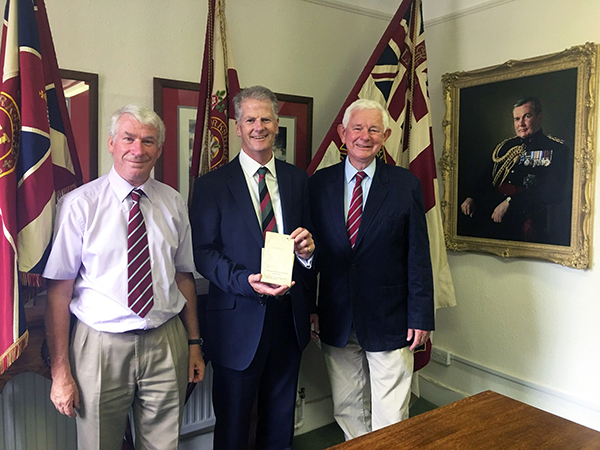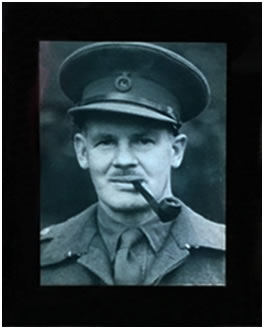Lt H K O’Kelly's Document of The Retreat
Dave Goodman lives in Dublin and served in the Royal Navy in nuclear submarines. Here is his story -
I was interested in finding out more information on both Pte Hickey and Lt. C. O’Kelly. On searching for Lt O’Kelly, I came across the following website: http://www.thedeathofthedukes.co.uk which had a reference to Lt O’Kelly of the Duke of Wellington’s Regt and I wondered if the details in the report would be of interest to the authors of the book so I wrote to them via the contact link. Bob Sargeant responded and I sent him a transcription which I had made of Lt O’Kelly’s report as well as a photographic copy of the front of the document...
My brother Bob sent Dave Goodman’s transcription of the O’Kelly document to me along with the photograph. As I had used most of Lt O’Kelly’s account (which I had discovered at the old ‘Dukes’ RHQ in Halifax) while writing ‘The Death of The Dukes’, I was fairly au fait with the contents – or so I thought. It immediately struck me, having handled many pre-war documents during my working life, that the photograph was of a document dating from the early to mid 1920s. However, just by looking at the cover of the document I could see a couple of flaws in its authenticity – or what I thought were flaws.
Firstly, the document referred to it being the work of Lt ‘C’ O’Kelly when Lt O’Kelly’s initials were, in fact, ‘H K’ – (for ‘Henry Kane’ O’Kelly). Secondly, it stated that he had previously been in the Special Reserve – i.e. the 3rd Battalion - but this was incorrect as O’Kelly had come straight from the Supplementary List, having just completed Officer Training at University. Then, after taking a quick glance through the transcription made by Mr Goodman I realised that there were several paragraphs that I had not seen previously. I checked the transcription against the copy of Lt O’Kelly’s account which I had made in 2002 at RHQ, Halifax. Then I checked that against O’Kelly’s account as it appears in ‘The History of the Duke of Wellington’s Regt [1st & 2nd Battalions] 1881-1923’ by Brigadier-General C D Bruce (1927). The copy I had seen and copied at RHQ was identical to the wording in C D Bruce’s book and even ended, rather abruptly, at the same strange place in the narrative. It was clear that some judicious editing must have been taken to the C D Bruce / RHQ versions. As the extra wording – totalling almost 500 words – was mostly of a highly emotive and possibly libellous nature I surmised that C D Bruce had probably omitted the offending words from his book as all the people concerned were likely to have still been alive in 1927.
The next mystery was how the version of Lt O’Kelly’s story found in C D Bruce’s 1927 book could be identical to the one found at RHQ yet slightly different to the one found in Dublin? After much deliberation I concluded that C D Bruce had probably ‘borrowed’ the ‘original’ version of O’Kelly’s testimony from the ‘Dukes’ Archive while researching his book but had neglected to return it. I would then have to presume that, after Bruce’s book was published in 1927, someone in the ‘Dukes’ Archive, realising that O’Kelly’s original account was ‘Missing In Action’, must have copied Lt O’Kelly’s account word-for-word from C D Bruce’s book using the foolscap paper and the old ‘Courier’ typeface of that pre-war period. Then they must have replaced the ‘original’ with the substitute account in the archive.
Next, I made a side-by-side comparison of the two versions – the Dublin Version and the version found at RHQ / C D Bruce - and put all the ‘extra’ wording found in the Dublin version in red. This comparison follows at the end of this account.
I do not know if there was ever a relationship between Henry O’Kelly and Charles Hickey, but both were “Old Contemptibles” and I wonder if Charles Hickey obtained a copy of the report which documented the actions in the area of operations in which he had also served. With regards to the ‘H. R.’ verses the ‘C.’ initials for O’Kelly - after the war, a lot of veterans in Ireland were ostracised for having served the Crown. There is a book by Kevin Myers “Ireland’s Great War”, and a theme runs through the book where relatives rarely provided details of their fallen in obituaries or on headstones. In his book, Myers writes “The redoubtable Jack Moyney VC told me that he had long since learnt to keep his mouth shut unless utterly sure of his company. When I first tried to get veterans of the war to discuss their experiences, some told me that they were in fear of their lives from the IRA. Absurd though that might now seem, that was the culture that had emerged. Moreover, neither schools nor universities – not even Protestant ones, or Trinity, which between them must have lost a thousand officers killed – broke ranks with the emerging nationalist orthodoxy of silence”. So, perhaps some of the subtle changes in Lt O’Kelly’s report were to mask his real identity. Veterans also had problems obtaining employment, especially in Public Service jobs.
https://www.theguardian.com/~/irish-soldiers-who-fought-for-britain
Dave Goodman kindly sent us the document which had been discovered in Dublin. The Trustees of the DWR Museum agreed that the Regimental Museum at Bankfield, Halifax, would be the best place to keep the document and so, with the agreement of Mr Goodman I sent it to my co-author Scott Flaving.
This story has a happy ending when, on 25th July, 2018, at the RHQ of the Yorkshire Regt, York (in which the Duke of Wellington’s Regt is now embodied) Scott Flaving (Hon. Sec. of the DWR Museum Trustees) handed the document to Lt Col (Ret’d) David O’Kelly of the Yorkshire Regiment’s HQ (David O’Kelly just happens to be the great-nephew Henry Kane O’Kelly!) and it was then handed by him to Major (Ret’d) David Harrap who is Chairman of the DWR Museum Trustees. (See photograph below). David O’Kelly was most grateful for sight of an original document belonging to his famous (and sometimes infamous*) great-uncle!
*You will have to read the book to find out more stories about Lt H K O’Kelly!

20th July, 2018. RHQ Yorkshire Regt, York.
Left– Scott Flaving – Centre - Lt Col (Ret’d) David O’Kelly (Holding the document) – Right - Major (Ret’d) David Harrap.
Photo taken by Catherine Giggal (Assistant Communications Officer, Yorkshire Regt).
The plan now is for the DWR Museum Trustees to consult a professional archivist with regard to finding a way to preserve the original document while still making it easily accessible to other researchers. This might involve unclipping the document from its split-pin and permanently unfolding the pages to prevent wear and tear every time they are examined. The unfolded pages could then be placed between transparent, acid-free, plastic sheets and stored flat.

Side by side
The ‘unfolded’ version found in the suitcase in Dublin (left) and Mr Goodman’s transcription.
CLICK HERE to see the side by side comparison
*
Additional Information -
Further to all the foregoing – after placing the two versions of Lt O’Kelly’s account on the Internet I was contacted by Sheelin, one of O’Kelly’s three children - who are all still alive. She was able to let me have a copy of a letter which her father had sent to his brother, Charley, in October, 1914. That letter contained O’Kelly’s account of the Retreat from Mons and is, in terms of content, exactly the same as the document which was found in the suitcase in Dublin. This rather proves my theory that Brig Genl C D Bruce must have edited O’Kelly’s account for his 1927 book and that the copy I found at RHQ Halifax in 2002 must, therefore, have been typed up from the C D Bruce book.
The person who typed up the ‘suitcase’ version was probably not a family member and may have put Charley’s initial ‘C’ at the head of the document by mistake as well as erroneously stating that he had been in the Special Reserve and not on the Supplementary List as was the case.
Meanwhile, we are making efforts to trace more of O’Kelly’s wartime letters.
Below is a photograph of Lt Col H K O’Kelly from WW2 when he commanded a Home Guard battalion.



